
Best For
- Designed specifically for children
- Super fast response time so kids don’t feel stuck
- Edges feel supportive while sitting (great for bedtime stories)
Considerations
- Adult guests who sleep on the mattress may feel support and pressure relief are lacking
- As kids get bigger they will outgrow the mattress (around age 12)
Our Verdict
The Nest Bedding Puffin mattress is a mattress specifically designed for kids, 110 lbs. or less. It uses a combination of poly foam and support foam for a balanced feel with its slimmer 7.0″ thick profile.
During our performance tests, it had fair cooling, deep sinkage, low motion transfer, extremely fast response time, moderately low bounce, good edge support, and good (but not great) pressure relief.
The Nest Bedding Puffin has an overall score of 8.34 which places it within the bottom 29% percentile compared to all mattresses tested to date. As far as just kids mattresses, it is within the top 25% of kids mattresses tested.
Even so, this is a solid mattress for supporting younger sleepers.
Type: Kids
Firmness: Slightly Firm (7)
Best For: Children (Body Weights Under 110 lbs.)
In This Review
Performance Tests | Firmness | Support & Sleeping Positions | Design | Materials | Comparisons | FAQs
Performance Tests
At NapLab, we put each mattress to the test.
We test 10 different factors that impact the performance, comfort, and value of the mattress. We then take the results of that test and compare to every mattress we’ve tested to date.
NOTE: Nest Bedding lists a 110-pound weight limit for the Puffin mattress. I personally performed all the tests in this review, although I do weigh 140 lbs. At 140 pounds, our tests definitely pushed the Puffin to its limits and beyond.
Check out the full performance table below to see how this mattress ranks:
| Factor | Nest Bedding Puffin | Average |
|---|---|---|
| Overall Score | 8.34 | 8.55 |
| Price (Queen) | $674 | $1,004 (Kids only) |
| Cooling – Score | 7.0 | 8.7 |
| Sinkage – Depth | 2.33″ | 2.14″ |
| Sinkage – Feel | Deep | Moderate |
| Motion Transfer – Score | 8.2 | 8.2 |
| Motion Transfer – Acceleration | 8.93 m/s² | 8.78 m/s² |
| Response Time – Score | 10 | 8.9 |
| Response Time – Mostly Recovered | 0.2 sec. | 0.4 sec. |
| Response Time – Fully Recovered | 0.3 sec. | 0.9 sec. |
| Bounce – Height | 7.66″ | 9.53″ |
| Bounce – Feel | Low | Moderate |
| Edge Support – Score | 8.4 | 8.6 |
| Edge Support – Sitting | 4.00″ | 4.04″ |
| Edge Support – Lying | Good | Good |
| Pressure Relief – Score | 8.0 | 8.7 |
| Comfort Layer Thickness | 2.0″ | 4.1″ |
| Mattress Thickness | 7″ | 12.0″ |
| Off-Gassing – Score | 9.7 | 8.1 |
| Off-Gassing – Smell | Minimal | Strong |
| Off-Gassing – Days | 1 day | 7 days |
| Company – Score | 10 | 8.8 |
| Trial | 365 nights | 178 nights |
| Warranty | Lifetime | 25% have lifetime warranties, average of other 75% of mattresses is 13 years |
How is Nest Bedding Puffin Different?
The Nest Bedding Puffin mattress has below-average performance, but also a price tag that is nearly 50% less than the average mattress for kids.
Advantages
Specific advantages include faster material response time, better edge support, and less off-gassing than average. The long 365-night trial period may also be a big advantage for some sleepers.
Neutral Factors
This mattress has 9% deeper sinkage than average as well as 20% less bounce than average. Both sinkage and bounce are still within an acceptable range and would be more issues of personal preference.
Disadvantages
Specific disadvantages for the Puffin include higher levels of motion transfer (compared to average), thinner 7.0″ mattress thickness, only 2.0″ of comfort material, and poorer cooling performance.
Cooling Test
Cooling on the Nest Bedding Puffin mattress is fair, but not particularly. During our tests, I definitely felt a noticeable level of heat retention and warming. It wasn’t a crazy hot level, but it also wasn’t nothing.
Baseline Temp.
73.9°F
Max. Temp.
88.0°F
Ending Temp.
78.5°F
Max. Temp.

Ending Temp.
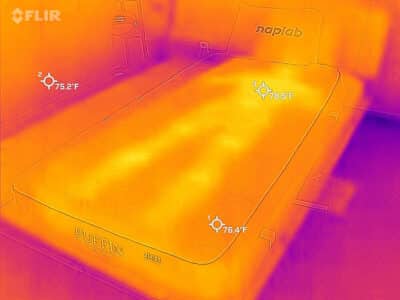
- Baseline Temperature – the temperature of the mattress before anyone lies on it
- Maximum Temperature (0 minute) – the temperature of the mattress after lying on it for 15 minutes
- Ending Temperature (5 minute) – the temperature of the mattress after being lied upon and having no one on it for 5 minutes
Looking at the design and material construction it makes sense. The mattress is 7” thick and 5” is a denser support foam base.
As a result, that’s a fair sizable percentage of total foam that has the propensity to absorb and retain heat more.
While the Puffin mattress does utilize a 2.0” layer of Energex on top (a branded poly foam), it’s not a thick enough comfort layer to prevent heat retention issues.
With all that said, we should note that our cooling test utilizes my adult-sized body on a kids’ mattress.
Heat Dissipation Over Time
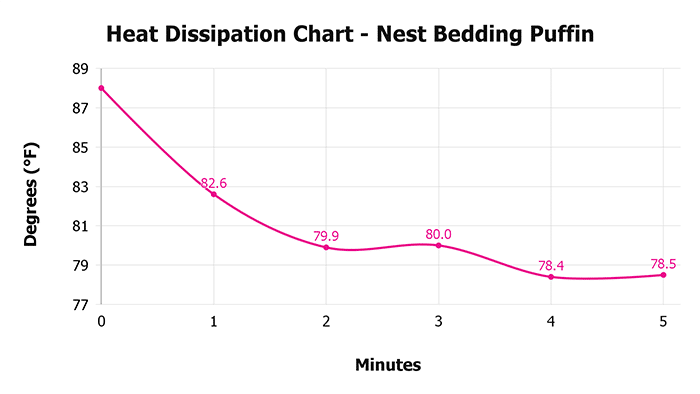
As a result, it’s not all that surprising that there were some heating issues. For adults who may sleep on the Puffin mattress from time to time, the cooling could be noticeable.
However, for kids, cooling is less likely to be an issue. Children’s relative size and weight just don’t put as much pressure or heat into the mattress as an adult body is going to.
Sinkage Test
In our pressure point sinkage tests, we measured 2.33” of sinkage on the Nest Bedding Puffin mattress.
Sinkage Depth
2.33″
Sinkage Feel
Deep
Body Contour
Balanced
This is deeper than the average across all mattresses we’ve tested to date, which is 2.14”. Quite frankly, I expected far more sinkage on the Puffin mattress.
The level of sinkage is documented in the image below.

With only 7.0” of total mattress thickness, the Puffin really has its work cut out for it when it comes to supporting an adult body.
However, the mattress did a fantastic job. It allowed plenty of sinkage to create appropriate levels of pressure relief but still has fantastic support capable of supporting even adult weights.
Note: The maximum weight recommended by Nest Bedding for the Puffin is 110 lbs., the same max as the Nest Bedding Lark mattress.
Motion Transfer Test
Motion transfer on the Puffin mattress was low. In our motion transfer tests, we measured a total acceleration range of 8.93 m/s².
Accel. Range
8.93 m/s²
Motion Duration
0.55 seconds
This is slightly more motion transfer than the average acceleration range of 8.78 m/s². A motion transfer acceleration range of less than 5.0 m/s² can be considered quite low. Puffin is a good bit beyond that.
The level of motion transfer is documented in the video below.
The Puffin’s relative thickness and firmness are both having a negative impact on motion transfer. Unlike thicker and softer mattresses, it doesn’t have the types of materials in sufficient quantities to significantly reduce motion.
Our motion transfer chart shows the full data picture from our accelerometer. By 0.22 seconds the vast majority of the energy has been dissipated.
A moderate level of energy persists up until 0.55 seconds, after which we see motion return to near-zero levels.
Motion Transfer Over Time
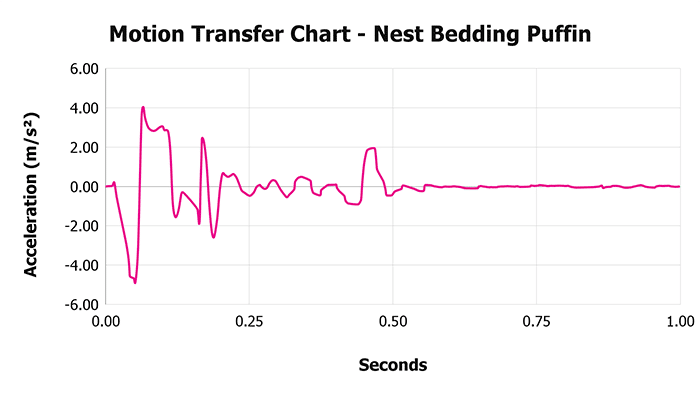
While motion dissipates fairly quickly, the peaks are still more significant compared to many other mattresses we’ve tested to date. All of that said, motion transfer generally isn’t as important a factor for child mattresses.
Response Test
Response time on the Nest Bedding Puffin mattress was lightning fast.
Mostly Recovered
0.2 sec.
Complete Recovery
0.3 sec.
In our tests, we measured a mostly recovered response time of 0.2 seconds and a fully recovered response time of 0.3 seconds. This is as fast as mattresses ever get.
The Puffin mattress is tied with a number of other mattresses for the fastest response time we’ve tested to date.
A fast material response time ensures sleepers never feel stuck in the mattress and it aids with ease of movement.
Bounce Test
Bounce on the Puffin mattress was moderately low. In our bounce tests, we measure a total bounce height of 7.66”.
Max. Depth
5.41″
Max. Rebound
2.25″
Total Bounce
7.66″
This is a good bit lower than the average bounce height across all mattresses we’ve tested to date, which is 9.53”.
Max. Sinkage Depth

Max. Bounce Height

Looking at the material construction of the mattress this bounce level makes sense.
The 5.0” layer of support foam is not designed to return significant levels of bounce, so that just leaves the 2.0” layer of poly foam (Energex).
The level of bounce is also documented in the video below.
While the Puffin isn’t the type of mattress you should be jumping around on, for most children, it’s going to be a perfectly acceptable level of bounce.
It’s enough bounce to feel comfortable and avoid feeling “dead”, but not so much as to create issues.
Edge Support Test
Edge support was surprisingly good on the Puffin mattress.
I say surprisingly because generally thinner mattresses (really anything less than 10”) perform worse when it comes to edge support.
Max. Sinkage
4.00″
Lying Support
Good
Reinforced Edge
No
In our sitting edge support tests, we measured 4.0” of compression. This is better than the average compression of 4.04”.
To be fair, 4.0” of compression on a 7.0” mattress is more relative sinkage than the vast majority of mattresses we’ve tested. Even so, I still felt that the mattress fully supported my weight and was not collapsing.
The level of edge support while seated is documented in the images below.
Sitting, 140 lbs.
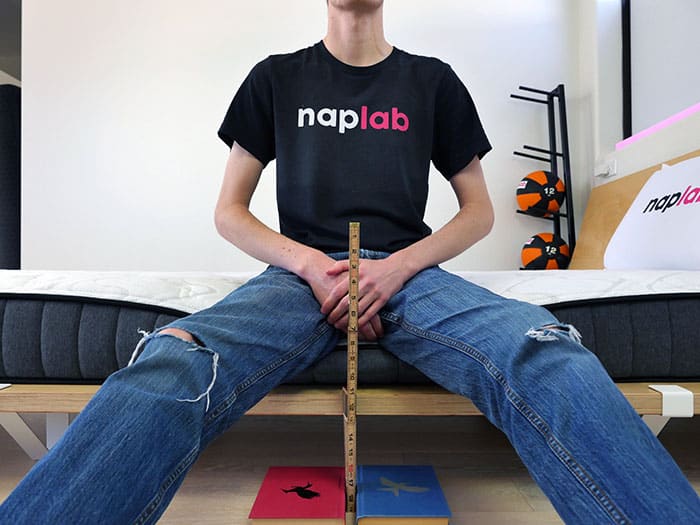
Sitting, 200 lbs.

If it’s able to support an adult’s sitting weight then there is no question that it will be sufficient for children.
It’s the type of mattress you could sit on the edge of to read bedtime stories without worrying that you’re going to damage the edge or slide right off of the mattress.
The level of edge support while lying is documented in the images below.
Lying on Edge, 140 lbs.

Lying on Edge, 200 lbs.

Lying edge support is good, just not great. Which really makes sense given the materials.
Because of how thin the mattress is, it’s really got pretty good lying support. For kids, it should be more than sufficient, though in the event an adult was sleeping on the mattress, it could be less than desirable.
Pressure Relief Test
Pressure relief on the Puffin mattress is good, just not great. The Puffin utilizes a quilted cover combined with 2” of comfort material.
While the comfort layer is doing as good as it can, at the end of the day it’s still pretty thin.
That said, for kids, the thickness of comfort material should be good enough…at least until they start getting bigger, say around age 12.
Comfort Layer
2.0″
Support Layer
5.0″
However, adults who need to sleep on the mattress (in a guest bed type of situation) may find the pressure relief just isn’t there.

The sinkage may be a little too deep for adults and bigger kids, which could create support issues and lead to uncomfortable pressure points.
Off-Gassing Test
There was a minor smell upon initial unboxing that lingered for just 1 day. Overall, this is a great performance.
Initial Smell Strength
Minor
Off-Gassing Period
1 day
On average, we see that most new mattresses have a strong smell that lingers for 7 days.

Not having to worry about a significant off-gassing period is a big win for the Puffin mattress. Most kids should be able to sleep on the Puffin mattress immediately after unboxing.
Company
The company score takes a look at factors that may influence your experience with the mattress.
Factors include length of the trial period, warranty, shipping / return costs, and country of origin.
| Company Factor | Factor Weight | Score | Data |
|---|---|---|---|
| Returns | 40% | 10 | $0 |
| Trial Period | 30% | 10 | 365 nights |
| Warranty | 20% | 10 | Lifetime |
| Shipping | 10% | 10 | $0 |
| Country of Origin | 0% | USA |
For Nest Bedding, these individual terms and conditions generated a company score of 10 out of 10.

Nest Bedding offers a long 365-night trial period with a lifetime warranty. Shipping is free and returns are free.
How firm is the Nest Bedding Puffin?
The Nest Bedding Puffin mattress comes in around a 7 out of 10 on the firmness scale. Bear in mind, that this is how I perceived the firmness as an adult. Nest Bedding considers this mattress to be much firmer than I thought it was.*
* All firmness ratings are scored based on the mattress firmness compared to 180+ other mattresses I’ve personally tested.

To a child, it is possible that this mattress could have a firmer feel since their weight will prevent them from engaging too far into the material.
Support & Sleeping Positions
Overall support on the Puffin mattress is good. For kids, the level of support should be great until age 12 or so.
| Support Factor | Data |
|---|---|
| Comfort Layer | 2.0″ |
| Support Layer | 5.0″ |
| Firmness | Slightly Firm |
| Body Contour | Balanced |
| Zoned Support | No |
| Reinforced Edge | No |
As Nest Bedding states, this mattress is only designed to support sleepers up to 110 lbs. Because of this, I would not recommend this mattress for older children, as it will likely lack the support that they need.

With only a 7” thickness, the mattress really is only ideal for supporting children’s bodies.
As bodies get heavier and need more robust support it’ll be time to make the switch to an adult mattress.
Design
The Nest Bedding Puffin mattress is a combination foam mattress that uses two different kinds of foam to provide comfort, support, and an ultra-fast response time. It is designed specifically for kids (110-lbs or less).
| Design Factor | Data |
|---|---|
| Type | Kids |
| Thickness | 7″ |
| Cover Type | Quilted |
| Weight | 40 lbs. |
| Has Handles | No |
| Fiberglass-Free | Yes |
| Ships in a Box | Yes |

Materials
The Puffin mattress has a simple two-layer design. The top layer is a 2.0″ latex-like poly foam and the bottom layer is a firmer, 5.0″ high-density support foam.
| Layer Type | Thickness | Layer Specs |
|---|---|---|
| Poly Foam | 2.0″ | 2.8 PCF |
| Support Foam | 5.0″ | 1.8 PCF |

The Cover
The cover of the Puffin mattress is about 1.0″ thick and uses cotton combined with Joma wool for comfort and softness. Nest Bedding’s Eco-Flex foam is quilted into the cover for added support and pressure relief.

The Layers
The top layer of foam is a poly foam that has the response time of a classic latex, but the contour of a memory foam. It is called Energex and its highly responsive design makes it a great option for children. This layer is 2.0″ thick.

Directly below the Energex is a classic slab of poly support foam. This bottom layer is roughly 5.0″ thick and designed to provide support and spinal alignment as you sleep.
Product Evolution
The Puffin mattress is pretty simple, but has it undergone any major changes since it was first launched? Basically, no. The biggest change was that the mattress received a new name.

When it was first launched, the mattress was called the “Big Kid Bed” and it was the only mattress specifically for children in the Nest Bedding lineup.
Today, the “Big Kid Bed” is now known as the Puffin and Nest Bedding has also added the Lark mattress, a natural latex mattress for kids.
Other Mattresses to Consider
Still not sure if the Puffin is the right mattress for your child? Here are three other top-performing mattresses that are also great for kids.
For Natural Latex
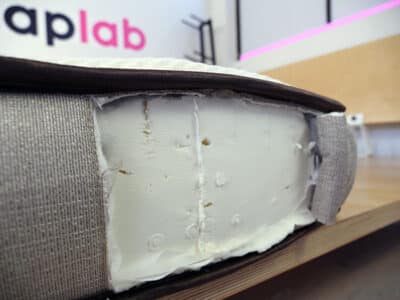
Nest Bedding Lark
7.0″ Thick Latex
The Lark is another great mattress designed for kids by Nest Bedding with a 7.0″ profile and made of natural Dunlop latex. It has better cooling performance, but also a slower response, less motion transfer, and poorer edge support.
For More Support
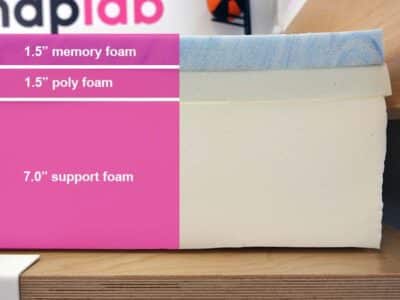
Leesa Studio
Combo Foam with 10″ Profile
The Leesa Studio mattress has a 3.0″ comfort layer followed by 7.0″ of support foam. If you’re looking for a combination of foams and a thicker profile, the Leesa Studio is a great option, and at a lower price than the Original Leesa.
For Thicker Profile

GhostBed Classic
Firmness 6.5 out of 10
If you want a balanced feel that has a thicker profile and can support adults, you may want to consider the GhostBed. This mattress is a little more expensive than the Puffin, but for a mattress that can support your child into their young adult years, the GhostBed is a solid investment.
Frequently Asked Questions
Still have questions? Check out some of the top FAQs on the Nest Bedding Puffin Kids mattress below.
Here are the current prices, with any sales or promotions reflected below:
Twin: $399
Twin XL: $449
Full: $599
This mattress is not available in larger sizes.
*Note: Sales prices are subject to change without notice or warning.
The trial is 365 nights, with a 30-night adjustment period.
If after the first 30 nights, you still don’t love it, you can request a return. Shipping and returns are free.
The Nest Bedding Mattress Warranty covers most defects for as long as you own your Nest Bedding mattress.
The original kids mattress by Nest Bedding was the BKB—Big Kids Bed. This mattress was later renamed the Puffin mattress, reviewed above.
Especially for younger children, a firmer mattress is best for children. As children get older and get used to the softness of a traditional mattress, personal preferences may warrant a softer mattress. Generally, a firmness of 6 or 7 out of 10 on the firmness scale, where 10 is the most firm, is appropriate for children.
As a company, Nest Bedding certainly makes a point to use non-toxic materials and fabrication processes. The Puffin contains CertiPUR-US certified foams and does not use a chemical fire barrier.



